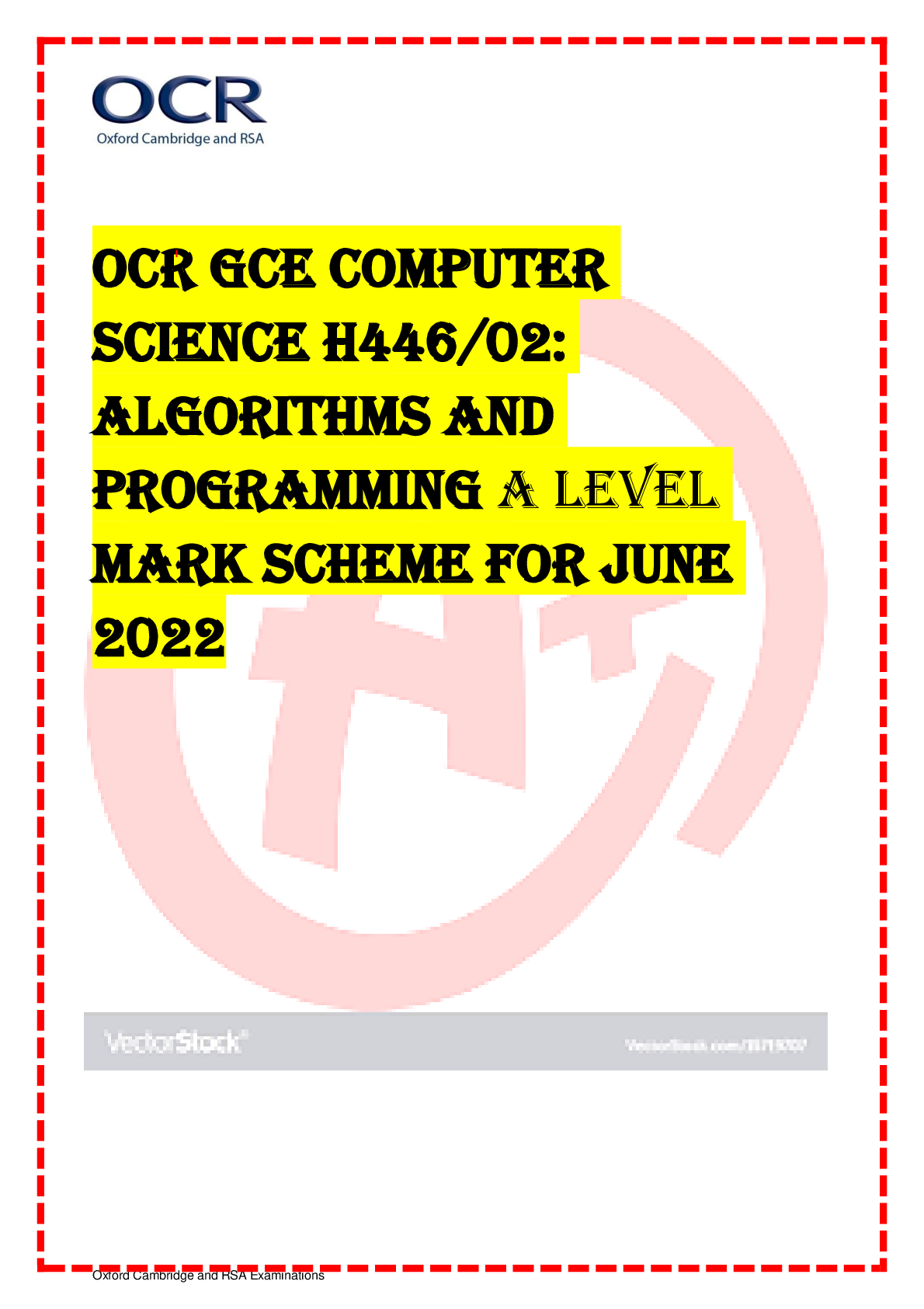Greek > AS Mark Scheme > GCE Classical Greek H444/03: Prose Literature Advanced GCE Mark Scheme for November 2020 (All)
GCE Classical Greek H444/03: Prose Literature Advanced GCE Mark Scheme for November 2020
Document Content and Description Below
Oxford Cambridge and RSA Examinations GCE Classical Greek H444/03: Prose Literature Advanced GCE Mark Scheme for November 2020Oxford Cambridge and RSA Examinations OCR (Oxford Cambridge and RSA)... is a leading UK awarding body, providing a wide range of qualifications to meet the needs of candidates of all ages and abilities. OCR qualifications include AS/A Levels, Diplomas, GCSEs, Cambridge Nationals, Cambridge Technicals, Functional Skills, Key Skills, Entry Level qualifications, NVQs and vocational qualifications in areas such as IT, business, languages, teaching/training, administration and secretarial skills. It is also responsible for developing new specifications to meet national requirements and the needs of students and teachers. OCR is a not-for-profit organisation; any surplus made is invested back into the establishment to help towards the development of qualifications and support, which keep pace with the changing needs of today’s society. This mark scheme is published as an aid to teachers and students, to indicate the requirements of the examination. It shows the basis on which marks were awarded by examiners. It does not indicate the details of the discussions which took place at an examiners’ meeting before marking commenced. All examiners are instructed that alternative correct answers and unexpected approaches in candidates’ scripts must be given marks that fairly reflect the relevant knowledge and skills demonstrated. Mark schemes should be read in conjunction with the published question papers and the report on the examination. © OCR 2020H444/03 Mark Scheme November 2020 Annotations Annotation Meaning Blank Page Benefit of Doubt Unclear Cross Extendable horizontal line Extendable horizontal wavy line Tick Omission mark Noted but no credit given Good response/positive Contradiction Slash AO1 AO2 AO3 MisreadH444/03 Mark Scheme November 2020 Subject Specific Marking Instructions Guidance on applying the marking grids for set text translation The general principle in assessing each section should be the proportion (out of 5) of sense achieved. One approach for each section is given. Acceptable alternatives will be illustrated during Standardisation, but examiners should assess on its own merits any approach that satisfactorily conveys the meaning of the Greek – the crucial consideration being the extent to which every Greek word is satisfactorily rendered in some way in the English. The determination of what a “slight” error is only necessary when it is the only error in a section; this distinction will then determine whether a mark of 5 or 4 is appropriate. Where marks of 4, 3, 2, 1 and 0 are applicable, the overall proportion of meaning conveyed in the section is the only consideration. The term “major” error has been used here to determine an error which is more serious than a “slight” error. The classification below should be seen only as a general guide, the intention of which is to maintain standards year-on-year. Lead markers should consider each instance on its own merits in the context of the passage and the section. The sort of errors that we would generally expect to be considered as “slight” errors would be: • a single mistake in the translation of a verb, for example incorrect person or tense • vocabulary errors that do not substantially alter the meaning • omission of particles that does not substantially alter the meaning (although in certain cases the omission of a particle may not count as an error at all, most especially with μεν... δε) The sort of errors that we would generally expect to be considered as “major” errors would be: • more than one slight error in any one verb • vocabulary errors that substantially alter the meaning • omission of a word or words, including alteration of active to passive if the agent is not expressed • missed constructions • alteration in word order that affects the sense The final decisions on what constitutes a “slight” and “major” errors will be made and communicated to assessors via the standardisation process (after full consideration of candidates’ responses) and these decisions will be captured in the final mark scheme for examiners and centres.H444/03 Mark Scheme November 2020 Marks Description 5 Accurate translation with one slight error allowed 4 Mostly correct 3 More than half right 2 Less than half right 1 Little recognisable relation or meaning to the Greek 0 = No response or no response worthy of credit.H444/03 Mark Scheme November 2020 MARK SCHEME Question Answer Marks Guidance 1 (a) Translation to be agreed at Standardisation. But, those of the house of Pisistratus who had come to Susa did likewise, using the same arguments as the Aleuadae, and offering Xerxes besides even more. They had with them Onomacritus, an Athenian oracle-seller, who had set in order the oracles of Musaeus; they had come with him as they were now reconciled to him after a quarrel. 5 Answer marked according to the 5-mark grid found in Appendix 1 Note that the translation given is only for guidance. Any accurate translation should be accepted, and marked in line with the grid in Appendix 1. Accept translation with reading of ἑτοίμας agreeing with σπονδάς to mean ‘available’. 1 (b) Inserted an oracle into the verses of Musaeus [1] into a prophecy that the islands of Lemnos would disappear under water [1] 2 1 (c) Onomacritus had been a close friend of the Peisistratidae, who praised him in the presence of the king [1]; they would omit prophecies [1] which suggested that the Persian cause would face set-backs [1], and only mentioned the ones which suggested the most fortunate outcomes for the Persians [1], claiming that it was ordained that he would bridge the Hellespont [1]. 5 1 (d) Answers should include an analysis of both the style and content of the passage. Elements which might be included are as follows: • ὦ δέσποτα – opening and choice of word; • use of ἄριστος and reference to εἶς τῶν γενομένων Περσέων ἄριστος ἀλλὰ καὶ τῶν ἐσομένων; • use of superlatives and repetition: ἄριστα καὶ ἀληθέστατα; 15 Answers should be marked in line with the assessment grid for 15 mark questions. Answers should focus on detail from the passage, and choose a range of examples from the set lines to exemplify their points.H444/03 Mark Scheme November 2020 Question Answer Marks Guidance • use of second person verbs (ἐάσεις) and choice of καταγελάσαι; • reference to a wide range of peoples (Sacae, Indians, Ethiopians and Assyrians) and the power of the Persians: καταστρεψάμενοι δούλους ἔχομεν; • vengeance theme: Ἕλληνας δὲ ὑπάρξαντας ἀδικίης οὐ τιμωρησόμεθα; • use of questions; • balancing sentences with τῶν ἐπιστάμεθα μὲν τὴν μάχην, ἐπιστάμεθα δὲ τὴν δύναμιν ἐοῦσαν ἀσθενέα; • conclusion with Mardonius’ personal experiences, and reference back to Darius as Xerxes’ father (including second person adjective, and first person pronoun); • reference to fighting against Athens.H444/03 Mark Scheme November 2020 Question Answer Marks Guidance 2 (a) • Behaves in a way that differs from other men (in relation to clothes, shoes and other bodily adornments)(1) • Keeps his soul as separate (1) from the body as possible (1) AO2 2 1 mark per point 2 (b) • Most men would consider that someone who pays no attention to the body doesn’t deserve to live (1) Someone that behaves like this is effectively dead already (1) AO2 2 1 mark per point 2 (c) • The body may prevent the soul / mind from gaining wisdom (1) • The body could be used as a ‘partner’ by the soul / mind in finding out the truth (1) • Physical senses (eg. sight & hearing) may help to identify the truth (1) • Poets maintain that human senses are not accurate – are they right? (1) AO2 3 1 mark per point 2 (d) Assess against criteria in the 5-mark AO2 grid (see above). …. καίτοι εἰ αὗται τῶν περὶ τὸ σῶμα αἰσθήσεων μὴ ἀκριβεῖς εἰσιν μηδὲ σαφεῖς, σχολῇ αἵ γε ἄλλαι: πᾶσαι γάρ που τούτων φαυλότεραί εἰσιν. ἢ σοὶ οὐ δοκοῦσιν; πάνυ μὲν οὖν, ἔφη. πότε οὖν, ἦ δ᾽ ὅς, ἡ ψυχὴ τῆς ἀληθείας ἅπτεται; ὅταν μὲν γὰρ μετὰ τοῦ σώματος ἐπιχειρῇ τι σκοπεῖν, δῆλον ὅτι τότε ἐξαπατᾶται ὑπ᾽ αὐτοῦ. Suggested translation: AO2 5 The following examples are intended to exemplify what might constitute a ‘slight’ or ‘major’ error. Individual slight errors: Individual major errors:H444/03 Mark Scheme November 2020 Question Answer Marks Guidance ‘And yet if these (two) perceptions about the body are neither accurate nor clear, the others are unlikely to be either: for they are surely inferior to them. Don’t you agree?’ ‘Yes, indeed’ he (Simmias) said. ‘Then when does the soul attain the truth? For whenever it tries to examine (the truth) with the body, it is clear that it (the soul) is deceived by it.’ 2 (e) Answers might include consideration of the following points, but need not be limited to these: - initial expression of agreement; ὡς ἀληθῆ λέγεις; - conclusions drawn from what has been said: ἐκ πάντων τούτων; - use of οὐκοῦν ἀνάγκη, and description of philosophers opinions; - use of ὥσπερ ἀτραπός τις; - logical presentation step by step of the argument; - interference of the body in the quest for truth and its significance for the soul as μετὰ τοιούτου κακοῦ; - contrast of body/soul made throughout; - effects of diseases; - political language in final sentence 15 Answers should be marked in line with the assessment grid for 15 mark questions. Answers should focus on detail from the passage, and choose a range of examples from the set lines to exemplify their points.H444/03 Mark Scheme November 2020 Question Answer Marks Guidance 3 (a) Translation to be agreed at Standardisation. When he drove out the army, Pythius, the Lydian, alarmed at a sign from heaven and emboldened by the gifts, came to Xerxes and said these things, “O master, I would like you to grant me a favour, which would be a small thing for you to do, but of great significance for me.” Xerxes, thinking that he would ask for anything other than what he was asking for, said that he would do this, and told him to say what he was asking for. 5 Answer marked according to the 5-mark grid found in Appendix 1 Note that the translation given is only for guidance. Any accurate translation should be accepted, and marked in line with the grid in Appendix 1. 3 (b) Lydius calls Xerxes ‘master’ [1] and explains that he has five children on the expedition against Greece [1]. Lydius asks that the king have pity on him [1] and release the eldest of his children from the expedition [1] so that he can care for his possessions [1]. 5 3 (c) Xerxes’ language: • ὦ κακὲ ἄνθρωπε • σὺ ἐτόλμησας • contrast of ‘you’ and ‘me’ • use of language of slavery: ἐὼν ἐμὸς δοῦλος 3 3 (d) Answer should include analysis of both the content and style of this narrative, and include points such as the following: • Xerxes as laughing (γελάσας) and his surprise (οἷον ἐφθέγξαο ἔπος); • use of direct speech (ἔφη) and imperatives (ἄγε εἰπέ μοι) and vocative (Δημάρητε); • use of personal pronouns (e.g. σὺ, ὑμῖν) and adjectives (e.g. κατὰ νόμους τοὺς ὑμετέρους); • use of numbers; 15 Answers should be marked in line with the assessment grid for 15 mark questions. Answers should focus on detail from the passage, and choose a range of examples from the set lines to exemplify their points.H444/03 Mark Scheme November 2020 Question Answer Marks Guidance • description of the Greeks, and its attribution to Demaratus combined with Xerxes’ disbelief (εἰ δὲ τοιοῦτοί τε ἐόντες καὶ μεγάθεα τοσοῦτοι); • concluding sentence (ὅρα μὴ μάτην κόμπος ὁ λόγος οὗτος εἰρημένος ᾖ).H444/03 Mark Scheme November 2020 Question Answer Marks Guidance 4 (a) Socrates uses pairs of opposites such as to argue for a process whereby the pairs are necessary to make sense of each other [1] the smaller comes from the larger [1] and the weaker from the stronger [1] and the worse the better [1] or the more just from the less just [1] 5 Flexibility should be allowed in the marking – if candidates refer to the argument prior to this and give only two of the examples given, they should be credited for their prior knowledge as well. 4 (b) Translation to be agreed at Standardisation. Therefore we have sufficiently established this idea, that everything happens in such a way that opposites come from opposites. Certainly. Now then, is there something of this sort in the midst of them, which is between both in the case of all opposites which are two, namely two kinds of generation, from one to the other, and then from that other back to the first, a froth and diminution between the greater and small thing; and this we call ‘increasing’ and ‘decreasing’? 5 Answer marked according to the 5-mark grid found in Appendix 1 Note that the translation given is only for guidance. Any accurate translation should be accepted, and marked in line with the grid in Appendix 1. 4 (c) In the cases of analysing and combining [1] or cooling and heating [1], there is a process of generation between them [1] 3 4 (d) Answers should including analysis and discussion of the style and content of the passage, with reference to the use of the dialogue format to inspire interest in the reader. Points which might be raised include the following, which can be backed up with any relevant examples: • use of questions (e.g. opening lines); • use of balancing pairs (e.g. τὰ ἴσα ἔστιν ὅτε ἄνισά); • negative responses from interlocutor (οὐδεπώποτέ, οὐδαμῶς etc); 15 Answers should be marked in line with the assessment grid for 15 mark questions. Answers should focus on detail from the passage, and choose a range of examples from the set lines to exemplify their points.H444/03 Mark Scheme November 2020 Question Answer Marks Guidance • personal nature of responses (ὦ Σώκρατες, οὐδαμῶς μοι φαίνεται, λέγεις); • variety of different examples, but with focus on ἰσότης • use of particles to give sense of dialogue; • use of superlatives vel. sim. (ἀληθέστατα, καὶ πολύ γε); • movement from concrete to abstract (οὐ ταὐτὸν ἄρα ἐστίν, ἦ δ᾽ ὅς, ταῦτά τε τὰ ἴσα καὶ αὐτὸ τὸ ἴσον…. πάσχομέν τι τοιοῦτον περὶ τὰ ἐν τοῖς ξύλοις τε καὶ οἷς νυνδὴ ἐλέγομεν τοῖς ἴσοις); • introduction and explanation of the idea of recollection; • homoioteleuton.H444/03 Mark Scheme November 2020 5 (a) Translation as agreed at standardisation: And on the fifth day they arrived at the mountain. The name of the mountain was Thekes. When the first men got to the mountain and they saw the sea, there was a great uproar. Having heard this Xenophon and those in the rear-guard thought that other enemies were attacking them in front, for they followed them from the burning land, and that the rearguard had killed some of them and taken others prisoner by making an ambush, and they took about twenty wicker shields covered in raw, shaggy ox-hides. 5 Answer marked according to the 5-mark grid found in Appendix 1. Note that the translation given is only for guidance. Any accurate translation should be accepted, and marked in line with the grid in Appendix 1. 5 (b) There was shouting that people ran towards it [1] and it seemed to get greater as more people got involved [1] and they heard the soldiers shouting ‘sea, sea’ [1] This is the end of a very long march [1] 4 Any three points based on the text. Additional points not given opposite, but based on the text should be allowed. 5 (c) Sense of chaos based on running here and there [1+1]; crying they embraced one another [1] gives a sense of joy [1]; sense of gratitude with the offerings made [1] 4 Answers should include reference to the emotions with some evidence for each. 5 (d) Candidates should analyse the passage, and use details from it to explain how Xenophon conveys the challenges of the situation both through the content and style of his writing. Points to be made could include the following, - Greeks are departing into numerous villages (ἐν πολλαῖς κώμαις); - there were numerous bees (τὰ δὲ σμήνη πολλὰ ἦν); - comment that there was nothing particularly strange, except the bees (τὰ μὲν ἄλλα οὐδὲν ὅ τι καὶ ἐθαύμασαν) to highlight the nature of this situation; - effects of eating the honey (πάντες ἄφρονές τε ἐγίγνοντο), with comments on ‘all’ and the notion of being ‘aphrones’; 15 Answers should be marked in line with the assessment grid for 15 mark questions. Answers should focus on detail from the passage, and choose a range of examples from the set lines to exemplify their points.H444/03 Mark Scheme November 2020 - further details of the effects on the soldiers (καὶ κάτω διεχώρει αὐτοῖς καὶ ὀρθὸς οὐδεὶς ἐδύνατο ἵστασθαι), and following examples from the text including the use of μεθύουσιν ἐῴκεσαν; - balancing phrases describing the condition of the men; - use of πολὺ μαινομένοις; - refence to men dying (οἱ δὲ καὶ ἀποθνῄσκουσιν); - state of the men emotionally (πολλὴ ἦν ἀθυμία); - change of fortunes and the resolution of the situation, especially the final comment (ὥσπερ ἐκ φαρμακοποσίας).H444/03 Mark Scheme November 2020 6 Candidates should show a range of knowledge about the character of both Xerxes and the Greek opposition which he faced, based on their knowledge of Book 7 of Herodotus. They should then evaluate the ideas in the question, especially the notion of avoiding oppression and the notion that Xerxes is a ‘crazed tyrant.’ To this end, they might include examples such as: - the notion of vengeance for the burning of Sardis and the dispute between the Greeks and the Persians as presented by Mardonius; - the ‘imperial’ plans as presented by various members of the Persian court and doubts about their validity as presented by Herodotus; - Artabanus’ words about the Greeks and the prophecy of a disaster; - the size of the Persian preparations and their geographical planning; - the multinational nature of Xerxes’ forces and its significance; - the episode of Lydius and Xerxes’ relationship with his followers; - the bridge and the whipping of the Hellespont; - the discussion between Demaratus and Xerxes and what it shows about the relationship between the Greeks and the Persians; - Xerxes’ expedition as being intended as the conquest of Greece (7.138); - The Athenians engagement with Delphi and its significance (7.140); - the fighting which takes place between Greeks and Persians, and Xerxes’ reactions. 20 Answers should be marked using the grid in Appendix 3. The content given opposite is indicative only, and should be used as a guide. Other relevant examples should also be rewarded. Answers should be in response to the question: “The Greek struggle to avoid oppression by a crazed tyrant.” To what extent would this make a good title for the sections of Herodotus’ work which you have read? Candidates should make reference to specific incidents in the prescribed book, both the sections which they have read in Greek and in English. Answers which argue for or against the proposition should be equally rewarded. Examiners should look for the quality of argument and the use of evidence within the argument, as well as evidence for a clear range of relevant examples.H444/03 Mark Scheme November 2020 7 Answers should consider the use of the scene made by Plato in the Phaedo. This will require them to give details of what is happening and the impending death of Socrates, and then discuss ways in which that scene is used to develop philosophical arguments. This might include: - arguments about the immortality and nature of the soul being particular pertinent to the occasion; - the character of Socrates and his courage and calmness in the face of impending death being used as a means to develop Plato’s messages; - the description of Socrates’ death and its significance; - discussions about what is known and whether or not death is to be feared; - the role played by Kebes and his significance within the discussions; - use of analogues within the arguments; - reference to past and future events, especially the events in the court and the impending death of Socrates. 20 Answers should be marked using the grid in Appendix 3. The content given opposite is indicative only, and should be used as a guide. Other relevant examples should also be rewarded. Answers should be in response to the question: ‘How effectively does Plato make use of the opportunities for philosophical discussion offered by Socrates’ final days in prison?’ Candidates should make reference to specific incidents in the prescribed books, both the sections which they have read in Greek and in English. Answers which argue for or against the proposition should be equally rewarded. Examiners should look for the quality of argument and the use of evidence within the argument, as well as evidence for a clear range of relevant examples.H444/03 Mark Scheme November 2020 8 Answers should consider the nature of Xenophon’s narrative, and the ways in which he attempts to make it interesting for the reader. This might include: - first hand nature of the narrative; - the use of dramatic episodes such as the ‘sea’ episode; - the description of the difficulties which the soldiers faced on the journey; - the depiction of the emotions felt by the soldiers as they made their way back towards Greece; - the geographical and other details which Xenophon includes to appeal to the readers’ interest in geographical questions. 20 Answers should be marked using the grid in Appendix 3. The content given opposite is indicative only, and should be used as a guide. Other relevant examples should also be rewarded. Answers should be in response to the question: ‘How successfully does Xenophon engage his audience in the sections of the Anabasis which you have read?’ Candidates should make reference to specific incidents in the prescribed books, both the sections which they have read in Greek and in English. Answers which argue for or against the proposition should be equally rewarded. Examiners should look for the quality of argument and the use of evidence within the argument, as well as evidence for a clear range of relevant examples.H444/03 Mark Scheme November 2020 APPENDIX 1: MARKING GRIDS FOR TRANSLATION For each set text, an extract of the set text will need to be translated. The extract will be marked according to following marking grid based on the proportion of sense of the translation. Marks Description 5 Accurate translation with one slight error allowed 4 Mostly correct 3 More than half right 2 Less than half right 1 Little recognisable relation or meaning to the Greek 0 = No response or no response worthy of credit.H444/03 Mark Scheme November 2020 APPENDIX 2: MARKING GRIDS FOR 15 MARK QUESTION For the analysis questions in Section A and Section B, the answers will be assessed using the following marking grid. Level Marks Level of response grid for analysis question 5 13–15 Highly perceptive, well supported analysis leading to convincing conclusions Very well balanced evaluation based on clear engagement with source/task Argument incisive, very well structured and developed Technical terms, where appropriate, accurately and effectively used Sustained control of appropriate form and register Legible, fluent and technically very accurate writing, conveying meaning well 4 10–12 Perceptive, generally well supported analysis leading to sound conclusions Balanced evaluation based on clear engagement with source/task Argument clear, well-structured and developed Technical terms, where appropriate, accurately and effectively used Good control of form and register Legible and technically accurate writing, conveying meaning well 3 7–9 Careful analysis with some support, leading to generally tenable conclusions Evaluation present and based on some engagement with source/task Argument coherent if possibly cumbersome and/or underdeveloped Some technical terms, where appropriate, accurately and effectively used Sound control of form and register Legible and generally accurate writing, conveying meaning clearly 2 4–6 Attempts at analysis with some support, leading toward acceptable conclusions Limited evaluation but some engagement with source/task Argument discernible if very cumbersome or underdeveloped Some technical terms, where appropriate, accurately used Some appropriate control of form and register Legible, generally accurate writing, conveying meaningH444/03 Mark Scheme November 2020 1 1–3 Occasional analysis with little support, indicating toward some acceptable conclusions Little evaluation and little engagement with source/task Argument difficult to discern Some accurate use of simple technical terms Some basic control of form and register Legible, generally accurate writing, clarity not obscured 0 Nothing relevant or creditworthyH444/03 Mark Scheme November 2020 APPENDIX 3: MARKING GRIDS FOR 20 MARK ESSAY For the essay questions in Section C, the answers will be assessed using the following marking grid. Level Marks AO2 description Marks AO3 description 5 9–10 Specific factual knowledge, selected with care Fully relevant to the question throughout Well supported with evidence and reference where required Strong awareness of context where appropriate 9–10 Highly perceptive, well supported analysis leading to convincing conclusions Very well balanced evaluation based on clear engagement with source/task Argument incisive, very well structured and developed Technical terms, where appropriate, accurately and effectively used Sustained control of appropriate form and register Legible, fluent and technically very accurate writing, conveying meaning well 4 7–8 Detailed, well-chosen factual knowledge Generally relevant to the question Mostly supported with evidence and reference where required Sound awareness of context where appropriate 7–8 Perceptive, generally well supported analysis leading to sound conclusions Balanced evaluation based on clear engagement with source/task Argument clear, well-structured and developed Technical terms, where appropriate, accurately and effectively used Good control of form and register Legible and technically accurate writing, conveying meaning well 3 5–6 Generally well-chosen factual knowledge with some detail Mostly relevant to the question Some supporting evidence and reference where required Some awareness of context where appropriate 5–6 Careful analysis with some support, leading to generally tenable conclusions Evaluation present and based on some engagement with source/task Argument coherent if possibly cumbersome and/or underdeveloped Some technical terms, where appropriate, accurately and effectively used Sound control of form and register Legible and generally accurate writing, conveying meaning clearly 2 3–4 Some appropriate factual knowledge, not always well chosen Partially relevant to the question Limited supporting evidence and reference where required Limited awareness of context where appropriate 3–4 Attempts at analysis with some support, leading toward acceptable conclusions Limited evaluation but some engagement with source/task Argument discernible if very cumbersome or underdeveloped Some technical terms, where appropriate, accurately used Some appropriate control of form and register Legible, generally accurate writing, conveying meaning 1 1–2 Restricted selection of factual knowledge, possibly with some inaccurate details Little material of relevance to the question Little supporting evidence and reference where required Context occasionally or very superficially inidicated 1–2 Occasional analysis with little support, indicating toward some acceptable conclusions Little evaluation and little engagement with source/task Argument difficult to discern Some accurate use of simple technical terms Some basic control of form and register Legible, generally accurate writing, clarity not obscured 0 Nothing relevant or creditworthy 0 Nothing relevant or creditworthyOCR (Oxford Cambridge and RSA Examinations) The Triangle Building Shaftesbury Road Cambridge CB2 8EA [Show More]
Last updated: 1 year ago
Preview 1 out of 23 pages

Reviews( 0 )
Document information
Connected school, study & course
About the document
Uploaded On
Oct 10, 2022
Number of pages
23
Written in
Additional information
This document has been written for:
Uploaded
Oct 10, 2022
Downloads
0
Views
47








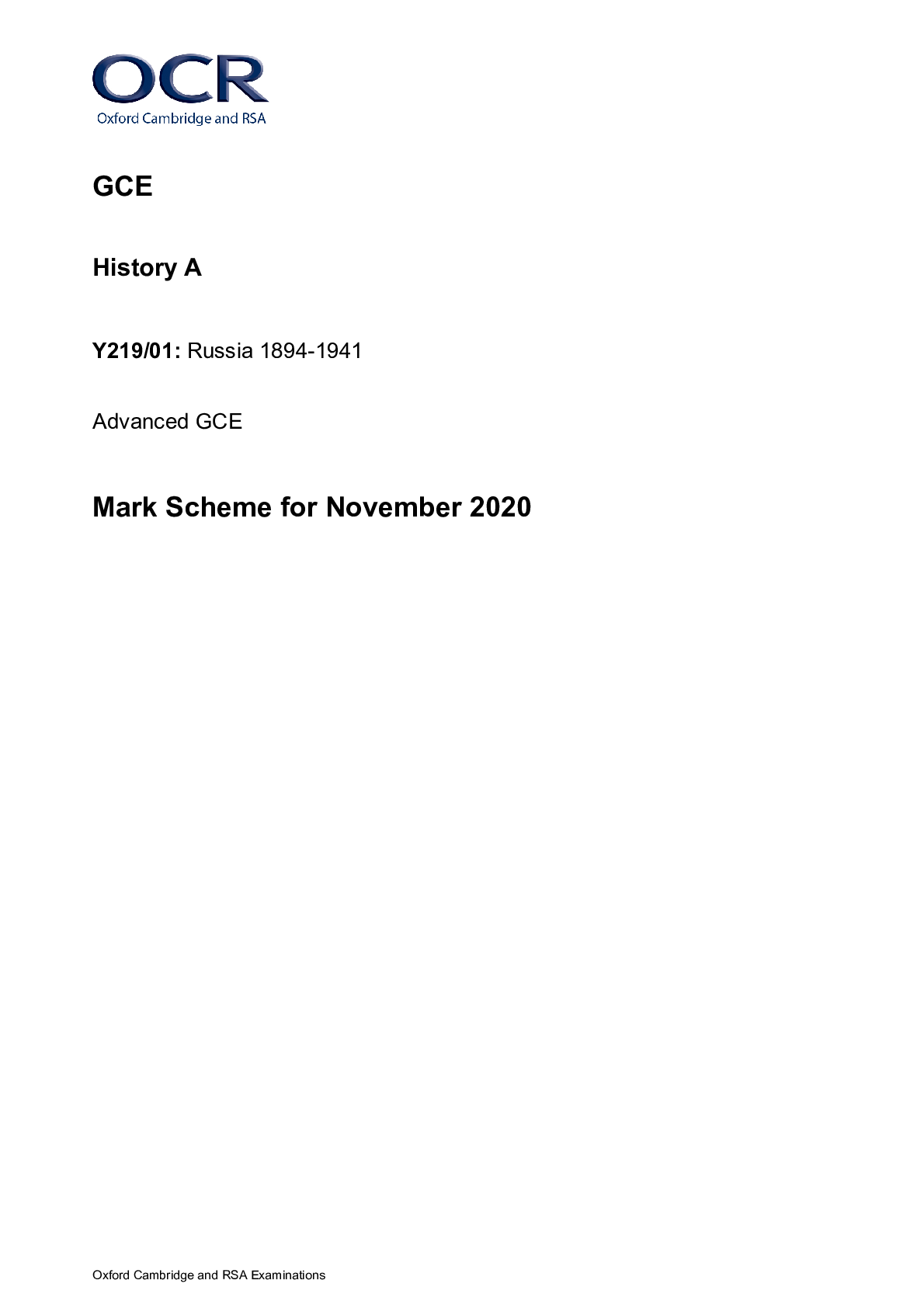
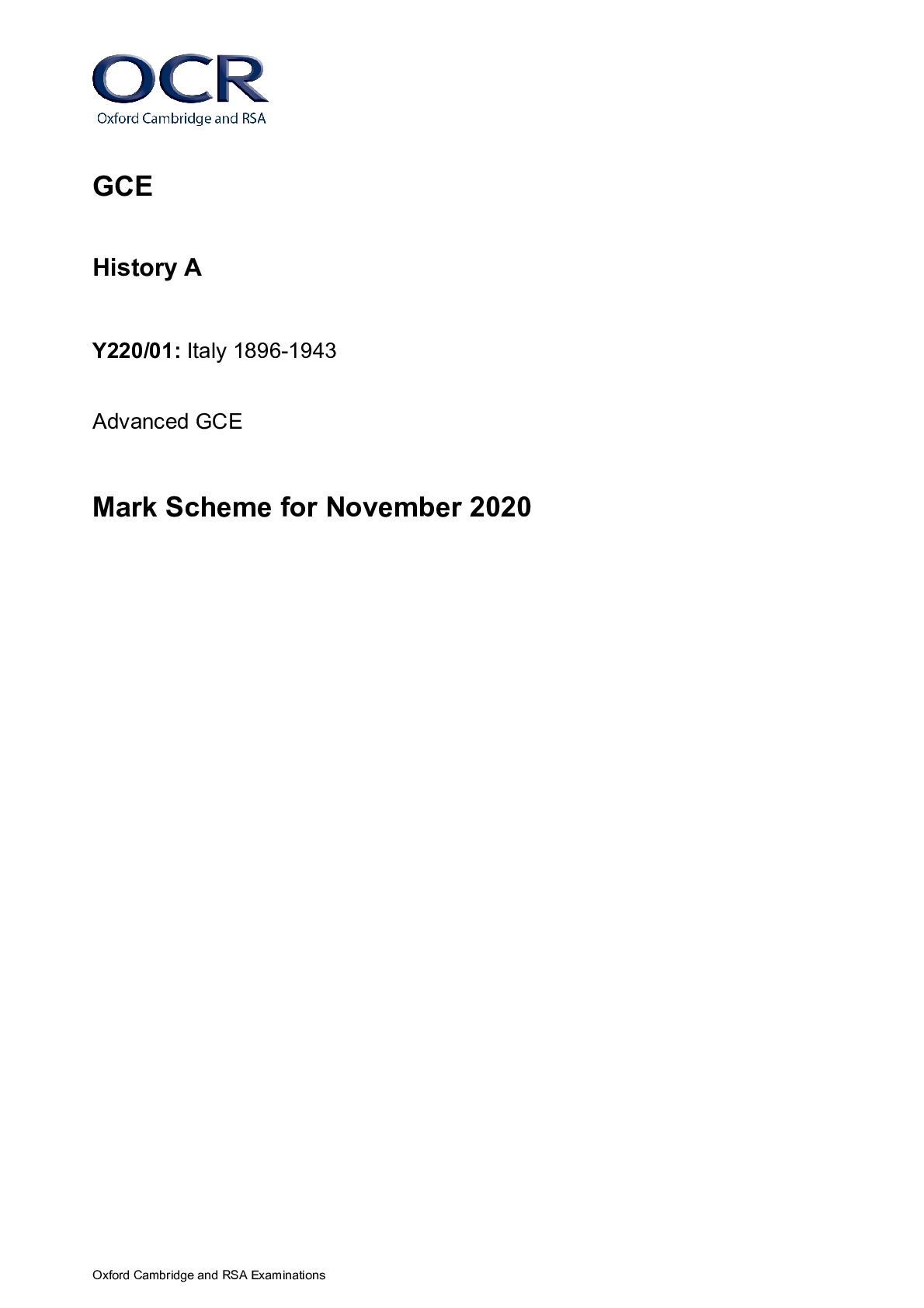

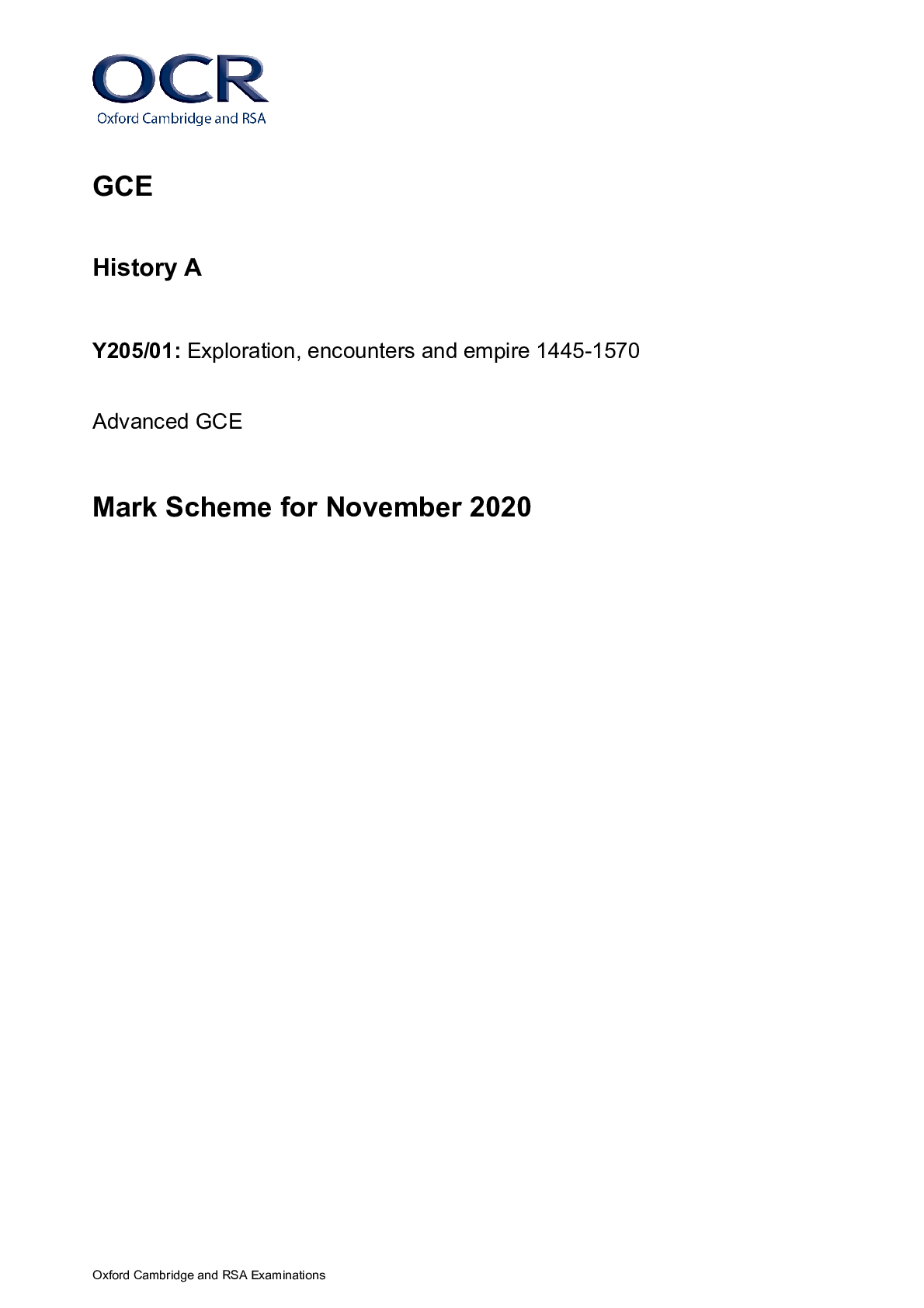
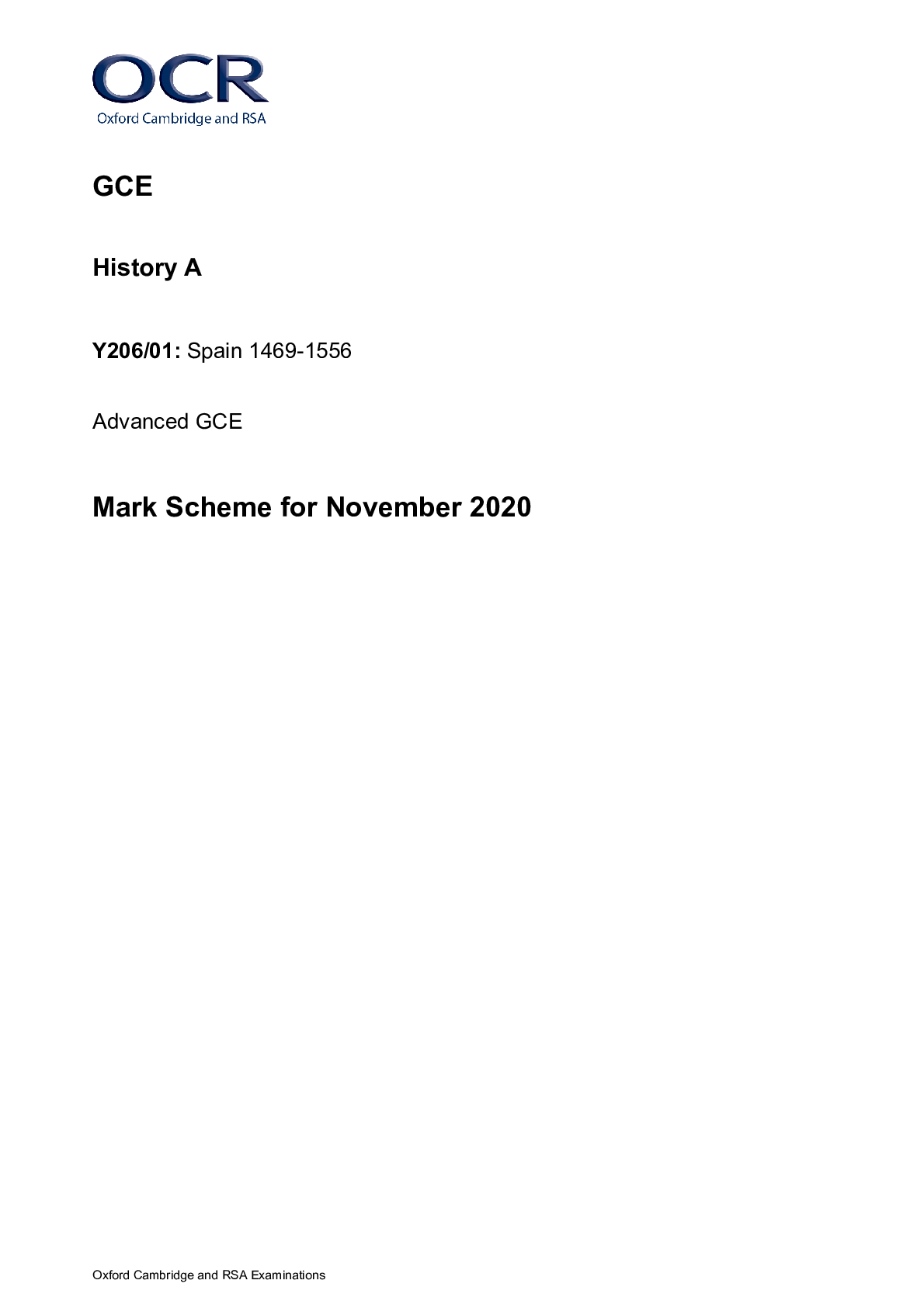
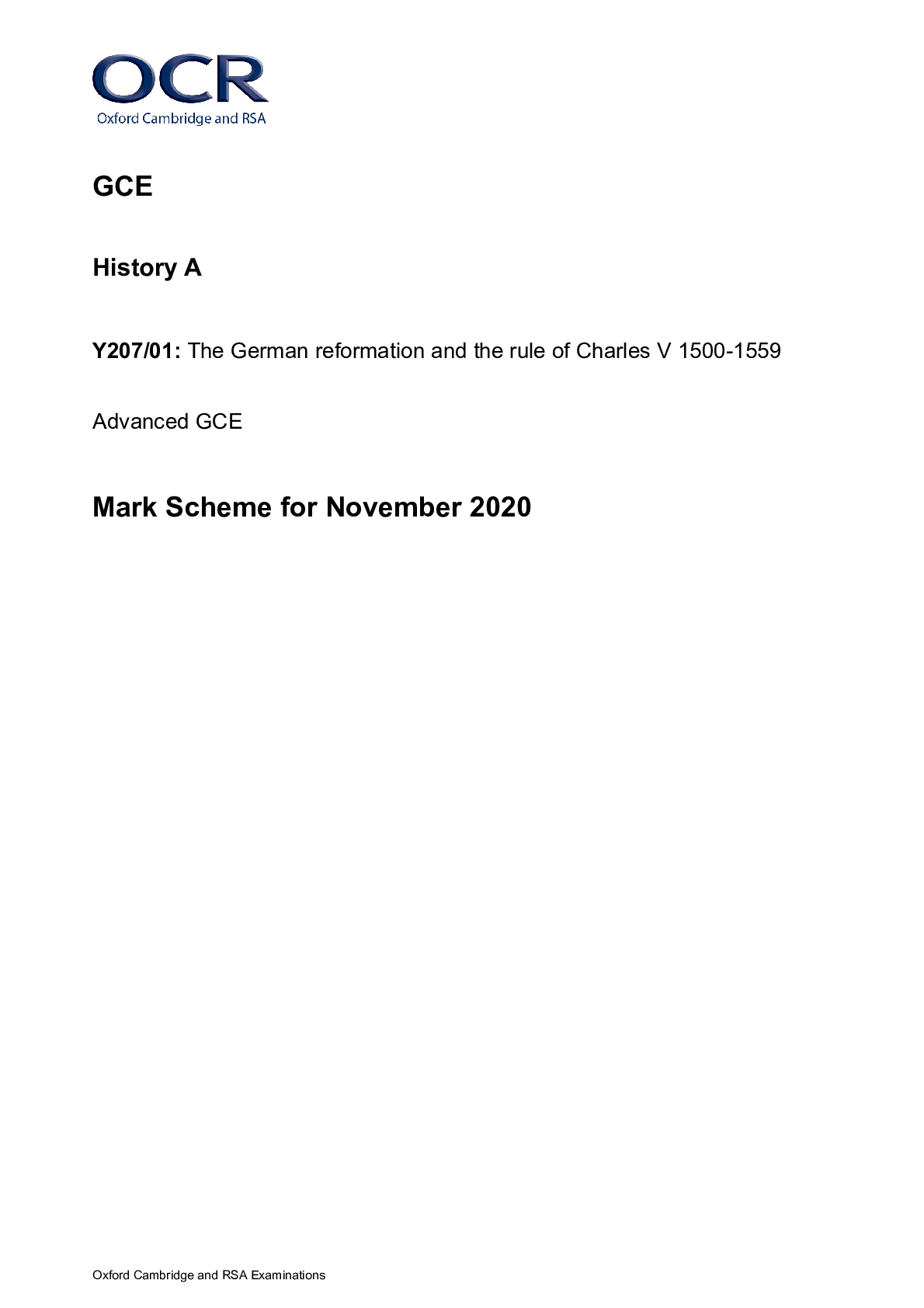
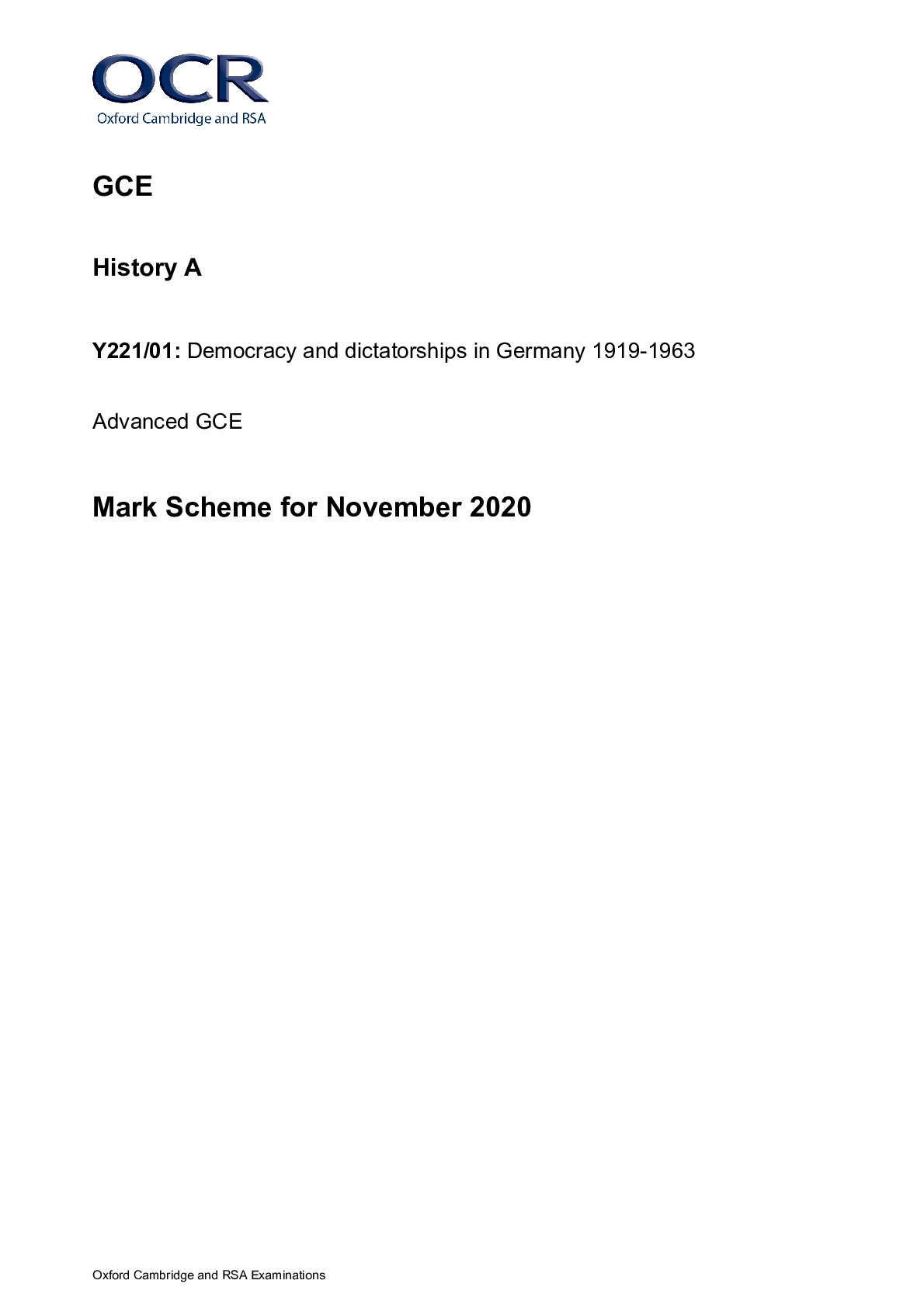

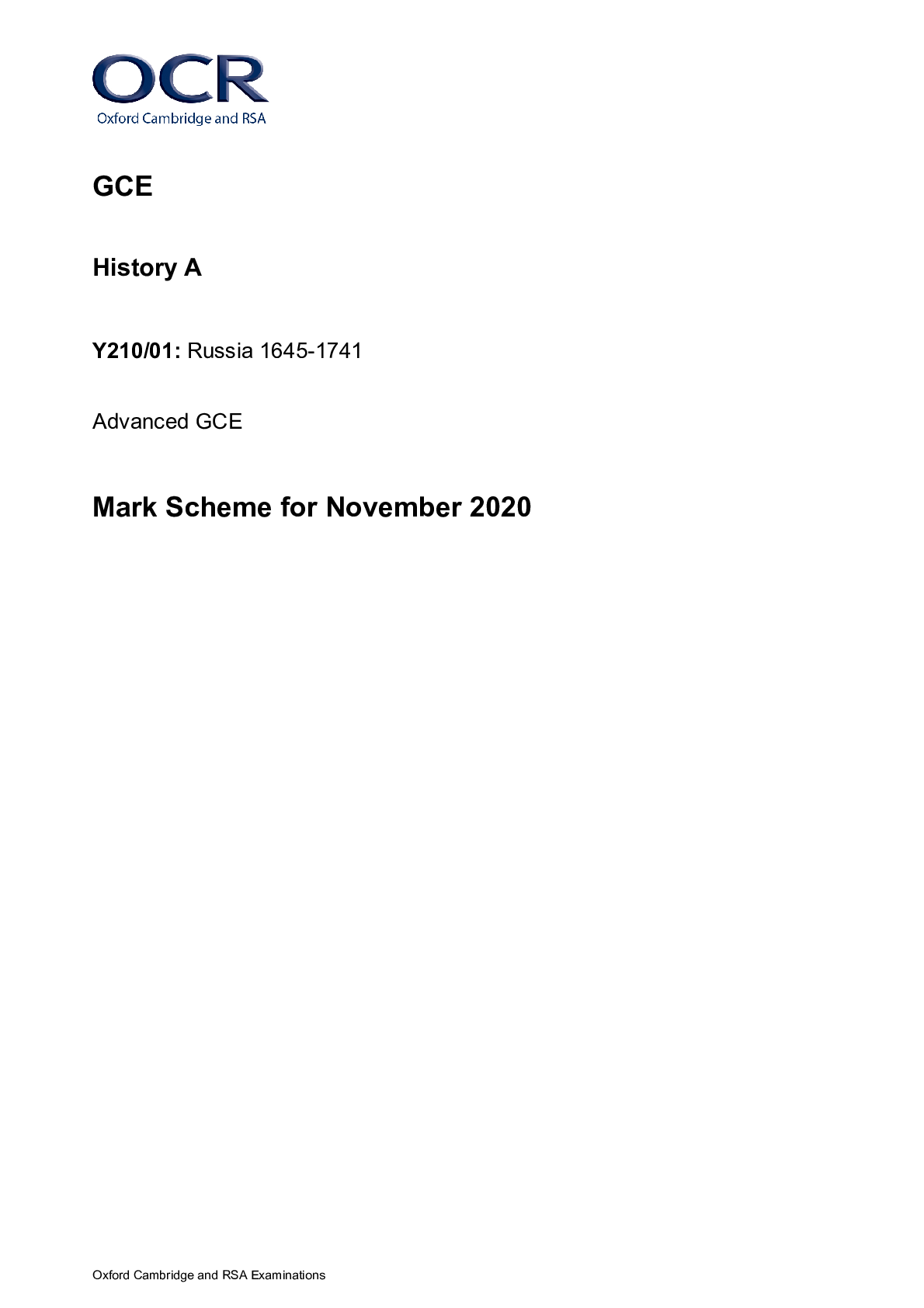


.png)



